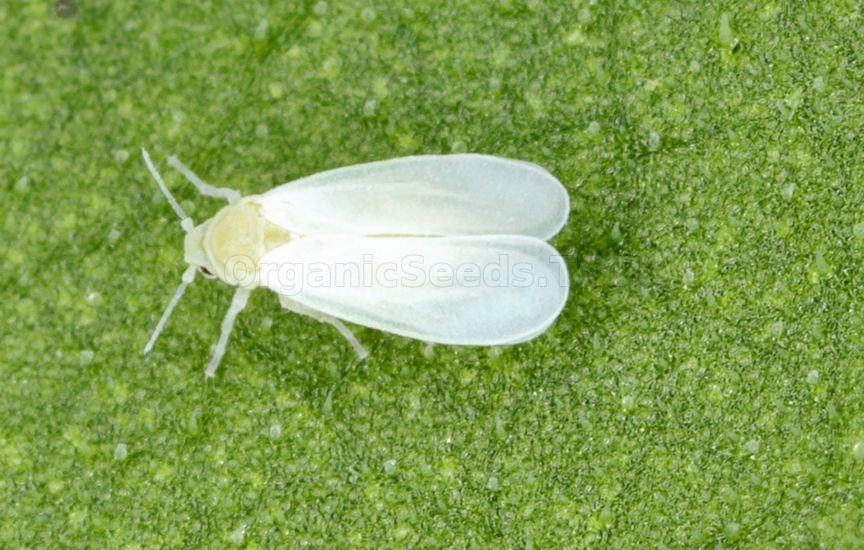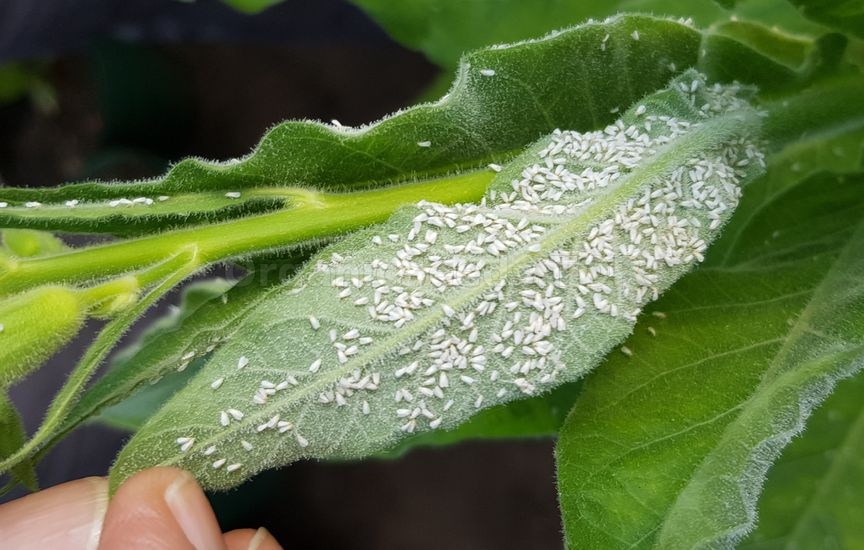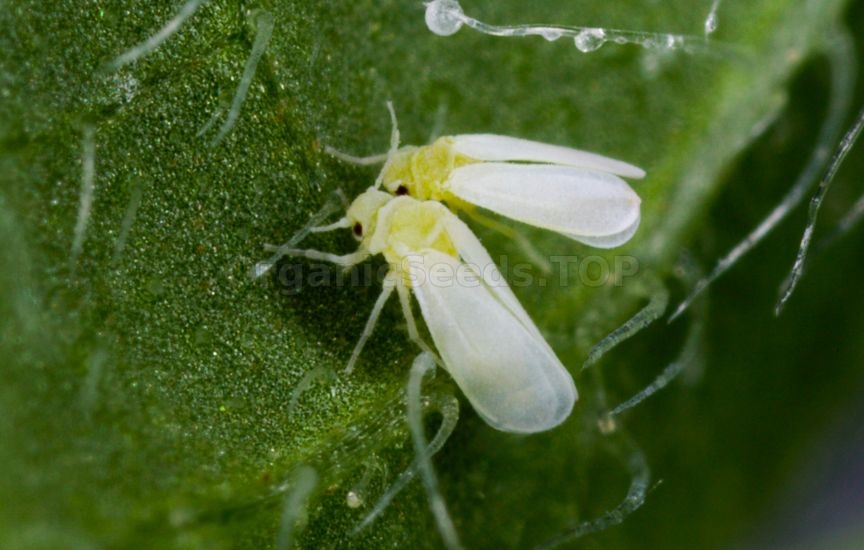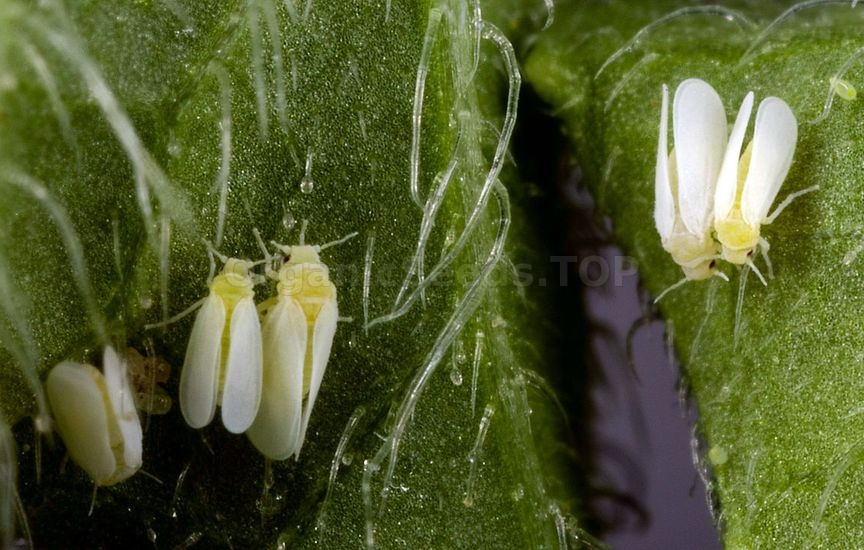Silverleaf whitefly - «Bemisia tabaci» |
 The Silverleaf whitefly - is a quarantine species, a broad polyphagous plant, which harms more than 200 plants from 73 families. Spreads viruses dangerous to plants. Prefers vegetable, melon, industrial, flower and medicinal crops, as well as many types of weeds. Found on fruit, berry, citrus, ornamental and forest woody plants. The transformation is incomplete. Reproduction is bisexual. The puparia overwinters. It spreads with plants in the egg, larval, and puparia stages. The pest produces from 8 to 15 generations during the growing season. MorphologyImago
Body yellow. The antennae and legs are light yellow. The wings are white, without spots. In a calm state, the wings meet tightly, at an acute angle. The abdomen is visible from above between the wings. The body length of the tobacco whitefly is 1-1.5 mm.  Sexual dimorphism Male. The latter is the abdominal sternite with two processes, between which the penis emerges. Female. There is an ovipositor, which consists of three pairs of valves. Egg The egg is pear-shaped, sometimes oval. Immediately after laying, the integument is pale yellow, then pale brown, and after the development of the embryo, golden brown. Length - about 0.2 mm. Larva The first instar larva is a wanderer, oval-shaped, flat, light green, with short two-segmented antennae and legs. All around the edge of the body and on the back it is covered with hairs, mobile. After the first molt, the larva loses its legs and antennae and becomes immobile. The older larva is pale green with red eyes. The body is flat, elongated oval, covered with spines, waxy secretions in the form of a fringe and two threads at the end of the body.  Puparium (6th generation larva) The puparia (6th century larva) is yellow or white-yellow in color, oval or oval with a pointed posterior end, strongly convex. The sides are wedge-shaped. The puparia is attached to the substrate with its medial part. Length - from 598 to 945 microns. Width - from 441 to 661 microns. The transverse suture does not reach the edge of the puparium by ¼ of its width, the longitudinal suture reaches the edge of the puparium or does not reach it. The edge of the puparia is crenate. There are two long folds on the chest part, sometimes a third short fold is visible. The marginal area is smooth or slightly striated. Submarginal granular or smooth. Along the edge of the segmented part along the medial line there are 1-4 or 1-5 abdominal segments. There are large tubercles on the anterior and middle chest. The total number of tubercles varies, sometimes they are absent altogether. On the thoracic and 1-6 abdominal segments there are two irregularly shaped depressions. The tracheal grooves are wide, slightly narrowed inside, formed by many tubercles. In small puparia, the tubercles have pointed tips or are absent. The thoracic tracheal ridges are poorly developed, their number varies from 5 to 7-9. Caudal tracheal ridges are not developed. Marginal setae short. Dorsal - 8 pairs. In the submarginal region there are from 2 to 4 pairs of short setae. When feeding on plants with smooth leaves, the dorsal setae of the puparia are most often reduced. The anus is located on the dorsal side of the puparium and has the shape of an elongated triangle. The operculum is triangular, with rounded corners at the base and a shortened apex, occupying less than half the size of the anus. The tongue is long, spear-shaped. The surface of the lid and tongue is strewn with small tubercles and bristles. There are two folds around the anus. One of them is located parallel to its lateral walls and passes into a clearly defined caudal groove. The second fold is intermittent and distant from the anus. Behind it, in the caudal groove, there are several tubercles.  DevelopmentImago
Heat-loving species. In the main part of the territory of Ukraine it cannot winter in open ground. Females live up to 60 days, males - 9-17 days. Females dominate the population. The sex ratio is 1:2. Individuals emerge through a T-shaped gap in the dorsal part of the puparium, spread their wings, file themselves with a waxy secretion from the glands on the abdomen, and begin feeding on food plants. Mating period Mating begins 12-20 hours after fledging and occurs several times in the life of the adult. Females lay eggs on the underside of leaves, in various layers of vegetation. The wide end of the egg touches the surface, its long axis is perpendicular to the leaf. It is fixed with a stalk that fits into a thin slit made by the female in the leaf tissue. Fertility - up to 160-300 eggs, on average 50-70. Egg An egg develops in 9 days at a temperature of 30°C. Larva The first instar larva is a wanderer or creeper. For several hours it actively moves in search of a favorable place for feeding. At this time, it moves freely along the underside of the leaf blade. Having chosen a suitable area, it attaches itself to the letter and feeds on the sap of the plant. Here she remains until her fourth age. As the larva develops, it loses its legs and molts three times. The first three larval stages last from 2 to 4 days each. The duration of the stage depends on the ambient temperature. Puparium (6th instar larva) The puparia (VI instar larva) lasts about 6 days. The body of the larva becomes more convex, and long bristles appear on the upper surface. At this stage, the final transformation into an adult insect occurs.  Abiotic factorsAt a temperature of 26.7°C, the duration of development from egg to adult lasts 18.6 days in cucumbers, 29.8 days in flax, tomatoes, and carrots. The pest overwinters in the puparia stage in the soil or on fallen leaves; overwintering is possible in the adult stage. During a season, from 8 to 15 generations can develop.
The Silverleaf whitefly - is a dangerous pest of more than 200 plant species from 73 different families. The larvae are harmful. When the pest multiplies massively, the leaves dry out and fall off. Various sooty fungi develop on sweet secretions, photosynthesis decreases, marketability is lost, and productivity decreases. The adult tobacco whitefly carries viral diseases of tobacco, cucumbers, cotton, tomatoes, and flower crops, resulting in the death of up to 80% of the crop.
You may need:«Silverleaf whitefly» trapPheromone traps |
|
|
